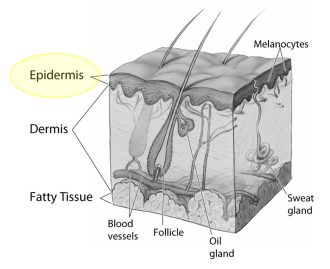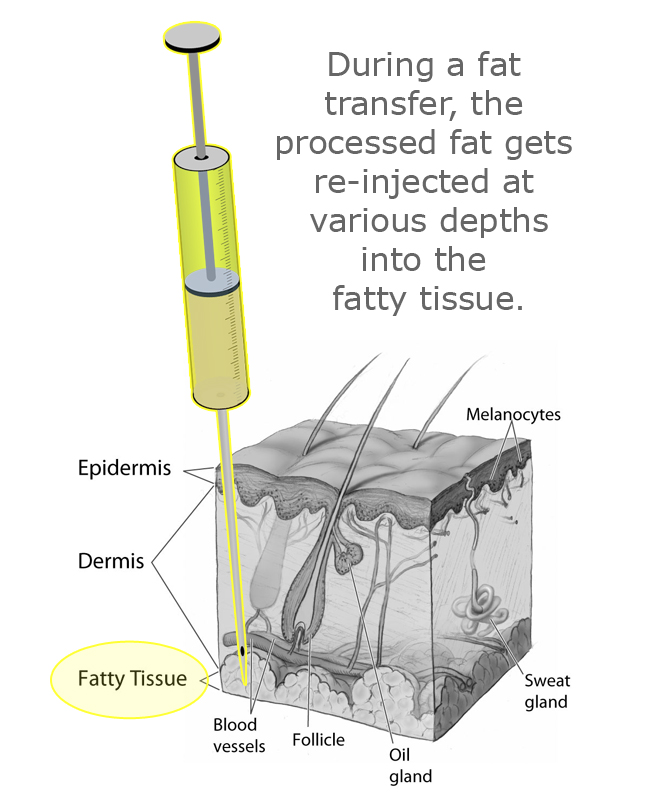
Laser resurfacing is a procedure which is aimed at rejuvenating the face. It basically works by injuring the top layers of your skin, the epidermis, causing a signal which promotes regeneration of new facial skin.
The laser destroys the top layers, your body sends signals to rejuvenate the area.
While laser skin resurfacing can be an effective method for prompting a fresher, more youthful facial glow, there are some risks that take place at various layers in the skin which can cause fat volume loss. Unfortunately, many FDA approvals for lasers do not include long term follow up for these types of complications. Laser companies take defensive positions, and hard data on complications is very difficult to attain.
In the past 15 years I have seen many patients from other practices with laser damage. I stopped doing laser completely around 2010 as the damage that I saw was from various types of lasers.
Why does this damage take place? With laser resurfacing, regeneration of the skin is prompted by destruction and that destruction can also cause fat volume loss.
An alternative to laser resurfacing is fat grafting
For facial rejuvenation , instead of using lasers, I prefer to rejuvenate the skin with fat grafting. Your own fat contains very tiny blood vessels. When that fat is injected into your face, more blood supply is introduced to your tissue matrix. With fat grafting, instead of a loss of volume, there is an increase in volume. Volume is increased by direct injection of fat as well as the fact that the process does not destroy cells as laser can do. To learn more, listen to the audio below or continue reading!
Lasers can trigger a process called apoptosis, aka cell death. Fat transfers do not destroy cells.
-Ricardo L Rodriguez, MD
With fat grafting, regeneration of the skin is prompted by signals sent by adipose stem cells which reside in the fat that is injected into the subcutaneous layer.
Why do some people experience facial fat loss after laser resurfacing?
Something that is designed to tighten your skin can actually end up causing damage further below the skin and to the fat tissue that’s right under the skin . . . ultimately resulting in a loss of volume. Hear me speak about it.
Anytime you introduce an energy source into the body, whether it be radiofrequency, or laser, or even CoolSculpting – which is specifically designed to injure fat cells – the cells that are damaged release what’s called DAMPs (Damage Associated Molecular Pattern Molecules, aka Danger Associated Molecular Pattern Molecules) and those DAMPs signal other cells.
If the signals are severe enough, or a particular kind, the DAMPS can trigger a process called apoptosis, which is programmed cell death, and that keeps on going for weeks or even months after the original injury. So patients who have had laser, or patients who have had radiofrequency, or patients who have had CoolSculpt, will continue to have subcutaneous fat tissue loss as a result of that.
How to correct facial fat loss after laser resurfacing?

The best correction for this, of course, is fat grafting. Fat grafting works in two ways:
1. It replenishes the fat that was lost.
2. The stem cells and regenerative cells in the fat restore the integrity of the tissue that was lost after the injury from the laser.
I now rarely, if ever, offer laser resurfacing as I feel that fat grafting does a much better job at facial rejuvenation. I have been talking about the benefits of facial fat grafting for years and I find that we are doing more and more facial fat grafting procedures as an alternative to facelifts.
Likewise, fat grafting is the perhaps the single best solution to fat loss that occurs following laser resurfacing. If you have had this happen, a fat transfer may be exactly what the doctor ordered!
The illustrations used in this articles were created using the skin (layers, glands, vessels) illustration by Don Bliss via Wikimedia Commons.
(Article originally published July 26, 2016)




Mary Crowley says:
Kay Alexander says:
Dr. Ricardo L. Rodriguez says:
Kyung says:
Dr. Ricardo L. Rodriguez says:
Justyna says:
Dr. Ricardo L. Rodriguez says:
Gail Hibberd says:
Dr. Ricardo L. Rodriguez says:
Lisa Moe says:
Dr. Ricardo L. Rodriguez says:
Mar says:
Dr. Ricardo L. Rodriguez says:
sam cho says:
Dr. Ricardo L. Rodriguez says:
Thomas Economous says:
Dr. Ricardo L. Rodriguez says:
Jess says:
Dr. Ricardo L. Rodriguez says:
Mel says:
Dr. Ricardo L. Rodriguez says:
Sim says:
Dr. Ricardo L. Rodriguez says:
matthew mccarty says:
Dr. Ricardo L. Rodriguez says:
Jessica says:
Dr. Ricardo L. Rodriguez says:
Jessica says:
Dr. Ricardo L. Rodriguez says:
J says:
Dr. Ricardo L. Rodriguez says:
Shannon L says:
Dr. Ricardo L. Rodriguez says:
Claudia says:
Leeza Rodriguez says:
Sunny says:
Dr. Ricardo L. Rodriguez says:
Ris says:
Dr. Ricardo L. Rodriguez says:
Emma Clark says:
Dr. Ricardo L. Rodriguez says:
Emma Clark says:
Dr. Ricardo L. Rodriguez says:
Lisa says:
Dr. Ricardo L. Rodriguez says:
Emma Clark says:
Dr. Ricardo L. Rodriguez says:
Belinda Osmond says:
Dr. Ricardo L. Rodriguez says:
Mark says:
Dr. Ricardo L. Rodriguez says:
Melanie says:
Dr. Ricardo L. Rodriguez says:
Rima says:
Dr. Ricardo L. Rodriguez says:
Vio says:
Dr. Ricardo L. Rodriguez says:
Vio says:
Dr. Ricardo L. Rodriguez says:
Taylor says:
Dr. Ricardo L. Rodriguez says:
Viola says:
Dr. Ricardo L. Rodriguez says:
Kay Alexander says:
Dr. Ricardo L. Rodriguez says:
Jared says:
Dr. Ricardo L. Rodriguez says:
Rosalyn Drage says:
Dr. Ricardo L. Rodriguez says:
Michelle martine says:
Dr. Ricardo L. Rodriguez says:
Kay Alexander says:
Dr. Ricardo L. Rodriguez says:
Kay Alrxander says:
Dr. Ricardo L. Rodriguez says:
Hope Unterschuetz says:
Dr. Ricardo L Rodriguez says:
Hope Unterschuetz says:
Dr. Ricardo L Rodriguez says:
ScienceBecomesHer says:
Dr. Ricardo L Rodriguez says:
Victoria says:
Dr. Ricardo L Rodriguez says:
Sarah says:
Dr. Ricardo L Rodriguez says:
Bonnie Inglis says:
Dr. Ricardo L. Rodriguez says:
bradd says:
Dr. Ricardo L Rodriguez says:
Hil says:
Dr. Ricardo L Rodriguez says:
Emily says:
Dr. Ricardo L Rodriguez says:
Juliana Micklos says:
Dr. Ricardo L Rodriguez says:
Valerie Austin says:
Dr. Ricardo L Rodriguez says:
Maria says:
Dr. Ricardo L Rodriguez says:
Vio says:
Dr. Ricardo L. Rodriguez says:
Vi says:
Dr. Ricardo L. Rodriguez says:
Vi says:
Dr. Ricardo L. Rodriguez says:
Lisa says:
Dr. Ricardo L. Rodriguez says:
Hope says:
Dr. Ricardo L Rodriguez says:
Catherine says:
Dr. Ricardo L Rodriguez says:
Kathryn says:
Dr. Ricardo L Rodriguez says:
Toni says:
Dr. Ricardo L Rodriguez says:
Amber says:
Dr. Ricardo L Rodriguez says:
Robert says:
Dr. Ricardo L Rodriguez says:
Virginia L Nahass says:
Dr. Ricardo L Rodriguez says:
Nancy Harrigan says:
Dr. Ricardo L Rodriguez says:
Kate says:
Dr. Ricardo L. Rodriguez says: